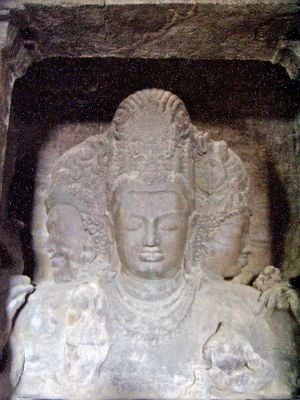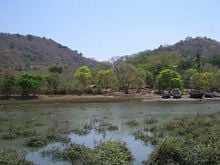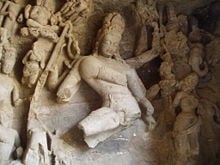Difference between revisions of "Elephanta Caves" - New World Encyclopedia
Dan Davies (talk | contribs) (imported, credited, claimed) |
Dan Davies (talk | contribs) (article imported) |
||
| Line 31: | Line 31: | ||
==Trimurti-Sadashiva Statue== | ==Trimurti-Sadashiva Statue== | ||
The most important sculpture is that of Trimurti Sadasiva, carved in relief at the end of the N-S axis. The image, 20 ft in high is if the three headed-Shiva, representing Panchamukha Shiva.<ref>Duffer's Guide to Elephanta, Mid-Day, Tinaz Nooshan, Feb 22, 2007, pg A14</ref> The right half-face shows him as a young person with sensuous lips, embodying life and its vitality. In his hand he holds something that resembles a rose bud — again with the promise of life and creativity. It is this face that is closest to that of [[Brahma]], the creator or [[Parvati|Uma]] or [[Vamadeva]],the feminine side of Shiva.<ref>HT Cafe, Mumbai, Monday, June,4,2007 pg.31 - Article 'Lord of the Islands" by Jerry Pinto</ref> The left half-face face on the side is that of a young man. It is moustached, and displays anger. This is Shiva as [[Aghora]] [[Bhairava]]<ref>HT Cafe, Mumbai, Monday, June,4,2007 pg.31 - Article 'Lord of the Islands" by Jerry Pinto</ref>, as the one whose anger can engulf the entire world in flames leaving only ashes behind. This is Shiva, the Destroyer. The central face, benign, meditative, as the preserver [[Vishnu]]. This is Shiva as the yogi — Yogeshwar — in deep meditation praying for the 'preservation' of humanity. | The most important sculpture is that of Trimurti Sadasiva, carved in relief at the end of the N-S axis. The image, 20 ft in high is if the three headed-Shiva, representing Panchamukha Shiva.<ref>Duffer's Guide to Elephanta, Mid-Day, Tinaz Nooshan, Feb 22, 2007, pg A14</ref> The right half-face shows him as a young person with sensuous lips, embodying life and its vitality. In his hand he holds something that resembles a rose bud — again with the promise of life and creativity. It is this face that is closest to that of [[Brahma]], the creator or [[Parvati|Uma]] or [[Vamadeva]],the feminine side of Shiva.<ref>HT Cafe, Mumbai, Monday, June,4,2007 pg.31 - Article 'Lord of the Islands" by Jerry Pinto</ref> The left half-face face on the side is that of a young man. It is moustached, and displays anger. This is Shiva as [[Aghora]] [[Bhairava]]<ref>HT Cafe, Mumbai, Monday, June,4,2007 pg.31 - Article 'Lord of the Islands" by Jerry Pinto</ref>, as the one whose anger can engulf the entire world in flames leaving only ashes behind. This is Shiva, the Destroyer. The central face, benign, meditative, as the preserver [[Vishnu]]. This is Shiva as the yogi — Yogeshwar — in deep meditation praying for the 'preservation' of humanity. | ||
| + | |||
| + | --------- | ||
| + | [[Image:India-Elephanta-Trees.jpg|thumb|220px|The island as seen from close to the boat landing.]] | ||
| + | [[Image:ElephantaRW1.JPG|thumb|220px|Sculpture inside a cave.]] | ||
| + | |||
| + | '''Elephanta Island''' (also called '''Gharapuri Island''' or ''place of caves'') is one of a number of islands in [[Mumbai Harbour]], east of [[Mumbai]], [[India]]. This island is a popular tourist destination for a day trip because of the island's [[cave]] [[temple]]s, the [[Elephanta Caves]], that have been carved out of rock. | ||
| + | |||
| + | The island is easily accessible by ferry from Mumbai, being about 10 km from the south east coast of the island city. Boats leave daily from the [[Gateway of India]], taking about an hour each way for the journey. From the boat landing stage on the island, a walkway leads to steps that go up to the famous caves. Along the path, hawkers sell souvenirs that may bought at a reasonable price. There are also stalls to buy food and drinks. | ||
| + | |||
| + | Known in ancient times as '''Gharapuri''', the present name '''Elephanta''', was given by [[17th century]] [[Portugal|Portuguese]] explorers, after seeing a monolithic basalt sculpture of an elephant found here near the entrance. They decided to take it home but ended up dropping it into the sea because their chains where not strong enough. Later, this sculpture was moved to the [[Victoria and Albert Museum (Mumbai)|Victoria and Albert Museum]] (now [[Dr Bhau Daji lad Museum]]) in [[Mumbai]], by the [[United Kingdom|British]].<ref>HT Cafe, Mumbai, Monday, June,4,2007 pg.31 - Article 'Lord of the Islands" by Jerry Pinto</ref> | ||
| + | |||
| + | The island has an area of 16 km² (6 sq miles). It is located at approximately {{coor d|18.95|N|72.93|E|}}. The area comes under the jurisdiction of the [[Raigad]] district in [[Maharashtra]] State. | ||
| + | |||
| + | A narrow gauge train takes tourists along the 1 km pier to the base of the steps which lead to the caves. | ||
| + | |||
| + | The island is thickly wooded with palm, mango and tamarind trees. The island has a population of about 1,200 involved in growing rice, fishing, and repairing boats. It was once the capital of a powerful local kingdom. | ||
| + | |||
| + | ==Electricity== | ||
| + | One of the most routine provision of electricity across the island. Electricity is supplied only between 7pm to 11pm. | ||
| + | |||
| + | ==References== | ||
| + | {{commonscat|Elephanta}} | ||
| + | * [http://www.mumbainet.com/travel/elephanta.htm Elephanta] | ||
| + | * [http://theory.tifr.res.in/bombay/architecture/building/elephanta.html Elephanta caves] | ||
| + | * Duffer's Guide to Elephanta, ''[[Mid-Day]]'', Feb 22, 2007, pg A14 | ||
| + | * [http://goldenboy.blog.com/2191551/ A blogger's description of the Island after having visited the Elephanta Caves] | ||
| + | {{Reflist}} | ||
| + | {{Islands of Mumbai harbour}} | ||
| + | |||
| + | <!--{{credits|173904928}} —> | ||
| + | |||
| + | |||
| + | --------- | ||
| + | |||
| + | |||
==Gallery== | ==Gallery== | ||
Revision as of 16:00, 14 December 2007
The Elephanta Caves are the focal point of the Elephanta Island, located in the Mumbai harbour off the coast of Mumbai (Bombay), India. In 1987, the caves were designated a UNESCO World Heritage Site.[1]
It is visited by many domestic and foreign tourists. In recent years, complaints have been made that visitors mistreat this important cultural and historic site.[2][3] Most of the sculptures here were defaced by the Portuguese, who used the sculptures as target practice in the 17th century. The Portuguese also gave the island its modern name,Elephanta from Gharapuri.[4]
The caves are thought to date back to the Silhara kings of the 9th through 13th centuries (810–1260). [citation needed] Some of the sculptures of this site are also attributed to the imperial Rashtrakutas of Manyakheta (in present day Karnataka), the Trimurti of Elephanta showing the three faces of Shiva almost akin to the Trinity of Brahma, Vishnu, and Mahesh. This was also the royal insignia of the Rashtrakutas. Other Rashtrakuta sculptures here are the reliefs of Nataraja and Sadashiva and the splendid sculptures of Ardhanarishvara.[citation needed]
The rock-cut temple complex cover an area of 60,000 sq ft consisting of a main chamber, 2 lateral ones, courtyards and subsidiary shrines. The site of these magnificent caves contained beautiful reliefs, sculptures, and a temple to the Hindu god Śiva. The caves are hewn from solid rock.[5] The temple complex is said to be the abode of Shiva.
Trimurti-Sadashiva Statue
The most important sculpture is that of Trimurti Sadasiva, carved in relief at the end of the N-S axis. The image, 20 ft in high is if the three headed-Shiva, representing Panchamukha Shiva.[6] The right half-face shows him as a young person with sensuous lips, embodying life and its vitality. In his hand he holds something that resembles a rose bud — again with the promise of life and creativity. It is this face that is closest to that of Brahma, the creator or Uma or Vamadeva,the feminine side of Shiva.[7] The left half-face face on the side is that of a young man. It is moustached, and displays anger. This is Shiva as Aghora Bhairava[8], as the one whose anger can engulf the entire world in flames leaving only ashes behind. This is Shiva, the Destroyer. The central face, benign, meditative, as the preserver Vishnu. This is Shiva as the yogi — Yogeshwar — in deep meditation praying for the 'preservation' of humanity.
Elephanta Island (also called Gharapuri Island or place of caves) is one of a number of islands in Mumbai Harbour, east of Mumbai, India. This island is a popular tourist destination for a day trip because of the island's cave temples, the Elephanta Caves, that have been carved out of rock.
The island is easily accessible by ferry from Mumbai, being about 10 km from the south east coast of the island city. Boats leave daily from the Gateway of India, taking about an hour each way for the journey. From the boat landing stage on the island, a walkway leads to steps that go up to the famous caves. Along the path, hawkers sell souvenirs that may bought at a reasonable price. There are also stalls to buy food and drinks.
Known in ancient times as Gharapuri, the present name Elephanta, was given by 17th century Portuguese explorers, after seeing a monolithic basalt sculpture of an elephant found here near the entrance. They decided to take it home but ended up dropping it into the sea because their chains where not strong enough. Later, this sculpture was moved to the Victoria and Albert Museum (now Dr Bhau Daji lad Museum) in Mumbai, by the British.[9]
The island has an area of 16 km² (6 sq miles). It is located at approximately . The area comes under the jurisdiction of the Raigad district in Maharashtra State.
A narrow gauge train takes tourists along the 1 km pier to the base of the steps which lead to the caves.
The island is thickly wooded with palm, mango and tamarind trees. The island has a population of about 1,200 involved in growing rice, fishing, and repairing boats. It was once the capital of a powerful local kingdom.
Electricity
One of the most routine provision of electricity across the island. Electricity is supplied only between 7pm to 11pm.
ReferencesISBN links support NWE through referral fees
- Elephanta
- Elephanta caves
- Duffer's Guide to Elephanta, Mid-Day, Feb 22, 2007, pg A14
- A blogger's description of the Island after having visited the Elephanta Caves
- ↑ Elephanta Caves. World Heritage Site. Retrieved 2006-10-14.
- ↑ Save the Caves. south-asian.com. Retrieved 2006-10-14.
- ↑ Elephanta Caves. Bolography. Retrieved 2006-10-14.
- ↑ HT Cafe, Mumbai, Monday, June,4,2007 pg.31 - Article 'Lord of the Islands" by Jerry Pinto
- ↑ Elephanta Caves. Mumbai Net. Retrieved 2006-10-14.
- ↑ Duffer's Guide to Elephanta, Mid-Day, Tinaz Nooshan, Feb 22, 2007, pg A14
- ↑ HT Cafe, Mumbai, Monday, June,4,2007 pg.31 - Article 'Lord of the Islands" by Jerry Pinto
- ↑ HT Cafe, Mumbai, Monday, June,4,2007 pg.31 - Article 'Lord of the Islands" by Jerry Pinto
- ↑ HT Cafe, Mumbai, Monday, June,4,2007 pg.31 - Article 'Lord of the Islands" by Jerry Pinto
| |||||
Gallery
Reference notes
External links
- Video of the caves MTDC site
- Elephanta Caves Photos from Himanshu Sarpotdar
- - Photographs of elephanta and other sites in maharashtra
- Information on the caves
- Description of Rashtrakutas architecture in the caves
- TempleNet - Elephanta Caves
- Elephanta Cave temple plan
- North enterance temple plan
- Travel guide to Elephanta Caves from Wikitravel
- Archaeological Institute of America Mumbai's Rough-Hewn Legacy Archaeology, February 12, 2007.
- God’s Night Out: A blogger's article written after a visit to Elephanta Caves
Template:Caves around Mumbai
| |||||||
Credits
New World Encyclopedia writers and editors rewrote and completed the Wikipedia article in accordance with New World Encyclopedia standards. This article abides by terms of the Creative Commons CC-by-sa 3.0 License (CC-by-sa), which may be used and disseminated with proper attribution. Credit is due under the terms of this license that can reference both the New World Encyclopedia contributors and the selfless volunteer contributors of the Wikimedia Foundation. To cite this article click here for a list of acceptable citing formats.The history of earlier contributions by wikipedians is accessible to researchers here:
The history of this article since it was imported to New World Encyclopedia:
Note: Some restrictions may apply to use of individual images which are separately licensed.










